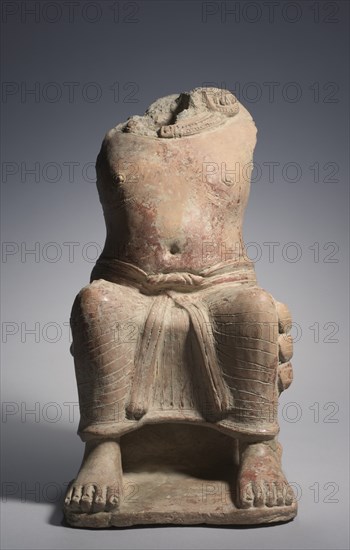
Sujet
Seated Yaksha, 300s. Creator: Unknown.
Légende
Seated Yaksha, 300s. Large images in the round are not common among Kushana terracottas, but they became much more popular during the Gupta period. This sculpture shows a headless, armless male seated European style on a perforated stool, his bare feet firmly on the ground. The posture is characteristic of heraldic royal portraits. This feature, as well as the corpulence of the figure with a protuberant belly, often associated with yakshas, suggests that the image may represent Kubera, Pancika, or Jambhala, the king of the yakshas. The deity wears an ankle-length dhoti with a long sash that falls between the legs. The folds of the garment are marked by regular parallel incisions--horizontal on the legs and vertical between them. He wears a heavy, short necklace and originally wore earrings, of which only the left one remains. There are also indications of a scarf around the neck on the back of the figure. The bare, plump torso with prominent breasts and deep navel, while still retaining the heftiness of the Kushana style, is indicative of the plasticity of the coming Gupta period. Terracottas of large size like this one were usually modeled freely, with the occasional use of molds or stamps for ornaments and decorations with final touches added by a chisel. To make them lighter, they were fashioned hollow, around a combustible core that burned away during the firing process. The back side of the stool was once broken and repaired.
Crédit
Photo12/Heritage Images/Heritage Art
Notre référence
HRM19G20_480
Model release
NA
Property release
NA
Licence
Droits gérés
Format disponible
45,6Mo (1,8Mo) / 27,0cm x 42,3cm / 3187 x 5000 (300dpi)